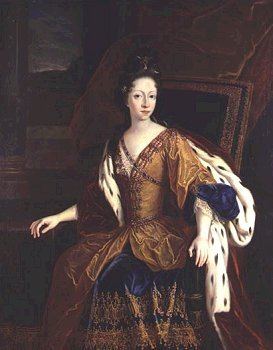Religion Lutheran | Name Princess Hedwig | |
 | ||
Born 28 August 1677Copenhagen, Denmark ( 1677-08-28 ) Parents Christian V of Denmark, Charlotte Amalie of Hesse-Kassel Cousins Prince William, Duke of Gloucester, Anne Sophia, Mary, George Grandparents Frederick III of Denmark Similar People Christian V of Denmark, Frederick IV of Denmark, Sophie Amalie of Brunswick‑Luneburg, Anne Sophie Reventlow, Christian VI of Denmark | ||
Princess Sophia Hedwig of Denmark (28 August 1677 – 13 March 1735) was a Danish princess, the daughter of King Christian V and his queen-consort, Charlotte Amalie of Hesse-Kassel (or Hesse-Cassel).
Biography
Sophia Hedwig was betrothed three times - first to John George IV, Elector of Saxony, then Joseph I, Holy Roman Emperor, and finally to her first cousin Charles XII, King of Sweden. However, none of the three marriages suggested for her transpired. The first groom broke the engagement, the second demanded she convert to Catholicism and the third did not wish to marry.
She became the object of marriage prospects early on. As a child, she became engaged to her cousin, John George IV, Elector of Saxony. This was in line with the traditional policy of dynastic marriage between Denmark and Saxony which had at that point become a tradition. In 1689, it was decided that the marriage was to take place two years later. When John George succeeded his father in 1691, he broke the engagement. In 1692, a marriage to the future Joseph I, Holy Roman Emperor, was suggested, and from 1694 to 1697, this plan was the object of considerable negotiations. However, Sophia Hedwig refused to convert to Catholicism despite considerable pressure to do so by her father, which terminated the negotiations. Between 1697 and 1699, there was a Danish policy to create an alliance with Sweden through a double wedding between Charles XII of Sweden and Princess Sophia Hedwig of Denmark, and Prince Charles of Denmark and Hedvig Sophia of Sweden (after the marriage of Hedvig Sophia in 1698, she was replaced by Ulrika Eleonora of Sweden). However, though somewhat encouraging to the idea of a Danish match if he would marry, Charles XII did in fact not wish to marry at all, and the Danish-Swedish alliance was further more met with great resistance by the Gottorp Party in Sweden. Sophia Hedwig remained officially unwed, although they were rumors that she entered a secret marriage with her courtier, the noble Carl Adolph von Plessen.
In 1699, her father died and was succeeded by her brother, Frederick IV. As was the custom, Sophia Hedwig lived with her mother until her mothers death in 1714, and after this at the court of her brother the king. Among her ladies-in-waiting was Elisabeth Helene von Vieregg, who would in 1701 be the lover of her reigning brother the King and, in 1703, his wife by bigamy. When her mother died in 1714, she inherited the estates Gjorslev and Erikstrup, which she switched with the king for the estates Dronninglund, Dronninggard and Borglumkloster.
She had a good relationship with her reigning brother until 1721, when she left the court with her younger brother, Prince Charles, in protest at the king's marriage with Anne Sophie Reventlow. The siblings settled with their own courts at the Vemmetofte manor, which Charles had inherited after their mother. They had a court of 70 noble courtiers, headed by Carl Adolph von Plessen, who was the friend of her brother Charles and possibly her own secret spouse. They did not make peace with the monarch until several years later. Sophia Hedwig, as well as Charles and von Plessen, founded schools for the peasantry on her estates, in accordance with her pietistic belief that schools were necessary to give religious instructions.
After the death of her brother Charles in 1729, she was his favored heir and inherited both his sizable estates Vemmetofte, Hojstrup and Charlottenborg, as well as his debts, which she managed to handle with the help of the income from the estates Sorgenfri Slot, Dronninggard and Frederiksdal, which she was granted by her nephew when he succeeded her brother in 1730.
She was a talented portrait painter and interested in music, handicrafts such as ornaments in ivory, and embroidery. She also collected psalm books and various writings. Many of her works are preserved in the Royal Danish Collection at Rosenborg Castle.
In 1735, the Vemmetofte Protestant convent for unmarried noblewomen was founded after instructions in her will. She died at the age of 57.
